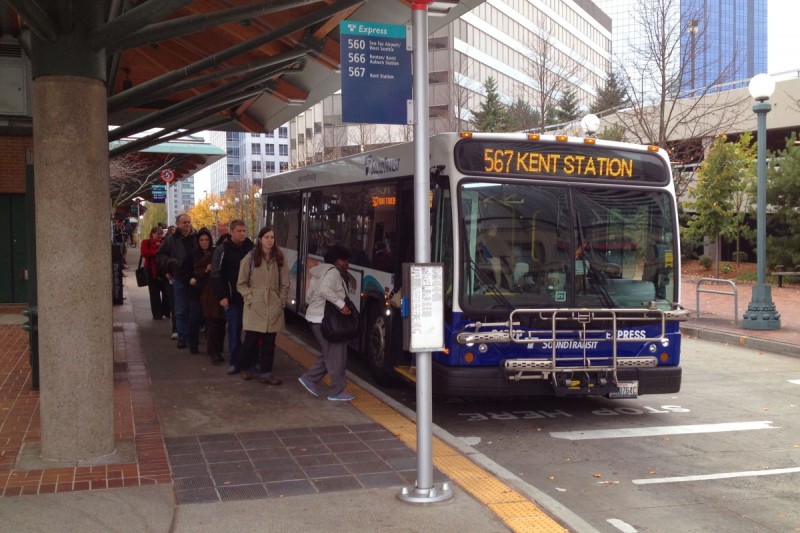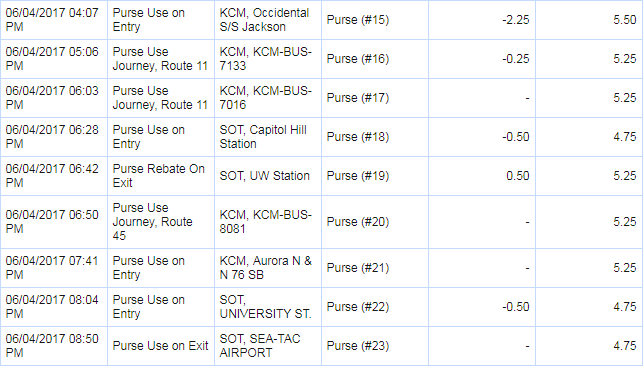In Seattle, transferring between transit modes is free. Here, you only get a discount.

Sound Transit buses in the Seattle area. Photo by Dan Reed. Image licensed under Creative Commons.
I’ve visited Seattle a few times recently, and while there I’ve used their bus, light rail, and streetcar. My experience transferring among these modes and several regional service providers leads me to say: I think the fare system out there is much… fairer, compared to ours.
In the DC area, we rely on a cornucopia of bus service providers that collectively stitch together coverage across our area – with the Metrorail system as a backbone for heavily-traveled corridors. The SmarTrip is the unifying element that allows for fare payment on nearly all of these services.
Transit providers in the Puget Sound region of Washington state, encompassing the Seattle/Tacoma metropolitan area, similarly rely on the ORCA card as their primary fare payment system. Contributor Michael Perkins wrote about ORCA and “PugetPass” back in 2010. PugetPass was the forerunner to SelectPass, which was created in late 2015 and rolled out in April of 2016 after years of advocacy from Michael and others.
The principle behind both SelectPass and PugetPass is that by paying for 36 one-way transit trips (the average number of morning and evening weekday commute trips in a given month) at a given price point, you can take an unlimited number of trips up to that price point at no additional charge. If you take a trip whose fare exceeds that pre-selected amount, you would only pay the difference from stored value on the card.
To be sure, SelectPass is a major improvement to the fare structure of transit in our area. But my exposure to Seattle’s system on several visits in the last couple of years have shown me that we still have a lot to strive for in order to make our transit fares/passes more equitable, user-friendly, and integrated.
Our system values one type of transit more than another
The fundamental difference between Seattle-area fares/passes and those in the DC area is that our fare structure reflects the fact that we treat transit service as a caste system: We have a higher caste (Metrorail), whose riders are relatively affluent and a lower caste (Metrobus, other local buses), whose riders are less so. Our fare structure discourages intermingling among the castes, and even penalizes those who do – even though the truncation of bus routes to rail hubs over the years has often forced bus riders into more expensive, multimodal commutes.
Functionally, these two systems should complement one another – as each can do things the other cannot and those who are most reliant on transit often can’t afford to live close to rail stations. Having a single entity – WMATA – operate both the rail system and the region’s largest bus system should theoretically make integration a simple prospect.
But in reality the Puget Sound area does a much better job of inducing its residents to view transit service holistically for one simple reason: Free transfers.
WMATA offers a relatively paltry discount for riders transferring from rail-to-bus and vice versa: 50 cents, a discount which has not gone up in recent years and which gets less significant with each fare increase. Enough has been written about the shortcomings of this approach, but a transit journey in Seattle offers a practical example of how it doesn’t have to be this way – even in a similar regional transit structure with arguably more dispersed service among several transit providers.
I rode all over Seattle and really only paid one fare
Unlike our region, Seattle’s primary transit provider is not yet its regional rail agency, Sound Transit, but rather the county bus system: King County Metro. Although Seattle’s “light rail” is a high-quality, high-capacity service that provides relatively quick trips in a mostly exclusively right-of-way, it did not begin service within city limits until 2009 and – despite a recent extension from downtown to the University of Washington – it is still not comparable to Metrorail in service coverage within the core (although that will gradually change over the coming decades).
So with the bus still King in Seattle for the time being and transit commutes not overwhelmingly weighted toward one mode or one provider, the area’s fare structure is necessarily integrated and more equitable.
Generally, fares are in the $2.50-$3.25 range for the most heavily-used services: Link light rail uses a distance-based fare structure similar to Metro that ranges from $2.25 to $3.25; bus fares within the city amount to $2.50 or $2.75 depending on whether they’re taken at off-peak or peak commuting times, respectively.
These fares are higher than Metro’s $2 off-peak rail and bus base fares, but critically, those Seattle fares are all-encompassing for transfers within two hours and — as my experience below shows — perhaps even longer.
The following screenshot shows my ORCA activity on the afternoon of June 4th, following a Seattle Mariners game at Safeco Field. The important columns are the third from left – which displays the service provider (KCM = King County Metro (bus/streetcar) and SOT = Sound Transit (light rail)) – and the two rightmost columns, which display the fare deducted and the overall card balance, respectively.
Here's what I paid to ride transit on June 4. Image by the author.
This usage log shows that $2.25 was deducted from the card when I took my first trip at 4:07pm, a northbound journey on the First Hill Streetcar to Capitol Hill. I had a beginning balance of $7.75, which with the deduction came down to $5.50.
The next two trips were on King County buses – a round-trip from Capitol Hill to Madison Park – for which only 25 cents were deducted from my balance since the bus fare ($2.50) was only 25 cents more than the streetcar fare.
The next trip was a brief, one-stop leg up to the University of Washington station in order to catch a connecting bus. You’ll notice that I was charged 50 cents on entry for this trip, representing the maximum possible fare from the Capitol Hill station.
Since Link uses a tap-in, tap-out system like Metro but does not have fare gates, the maximum possible fare is charged on entry to facilitate fare inspection and to cajole people into “tapping out” when they reach their destination. Indeed, you’ll see that on the following line, 50 cents was rebated to my card on exit at UW Station because the proper fare for that trip was only $2.25 – less than the cost of the King County bus that had been my fare high watermark.
The next two trips are on buses, from UW to the Phinney Ridge area and then from Phinney Ridge to downtown. By now, I had long since eclipsed the two-hour transfer window from my initial trip, yet these additional trips accrue no further charge.
The final two entries reflect a light rail trip from Downtown to SeaTac Airport – for which I was properly charged the maximum fare of $3.00.
The final tally? Five hours, seven trips, three distinct modes (four if you count a BRT-lite service as distinct from regular bus), perhaps 30 minutes of total wait time on a Sunday, and a cost of…$3. All over the following coverage area:
A map of everywhere I rode in Seattle. Click for an interactive version. Image by the author.
This can be us
To be certain, the travels of a tourist looking to get dinner, pick up things from an Airbnb, and get to the airport are not reflective of your “average” transit journey. But for a user who is performing multiple errands or for someone who can’t complete their trip on one mode or with one agency – or who simply wants the flexibility to choose which mode to take (depending on traffic, service conditions, etc.) – the flexibility and simplicity of Seattle’s “one fare” system is very alluring.
It’s also light on the wallet: A $3.25 PugetPass that covers the longest and most expensive light rail trip and any regional, non-commuter-bus trip costs less ($117) than the least expensive, $2.25 SelectPass if you want a bus option ($135).
What’s more, because the ORCA unified fare extends to trips taken on suburban buses (think Ride-On and Fairfax Connector), there is no worrying about which provider performs what service for its implication on your bottom line. Right now, WMATA’s regional bus pass provides such fare interoperability among Metrobus and county services, but doesn’t include rail service; meanwhile, SelectPass even with the bus option doesn’t include non-WMATA bus services. In the future, if the status quo fare structure holds, the more bus service that counties take over from WMATA, the less integrated our fare system will be.
It doesn’t have to be this way. We can stem the decline in rail and bus ridership – as New York did in the 1990s – by making rail-to-bus transfers free, and we can use the Puget Sound framework for making this possible on a regional scale. Just as we must invest in the capital components of Metrorail and Metrobus service – we also must invest in riders by moving toward an equitable, affordable, and simple fare model that will make these services more competitive.
